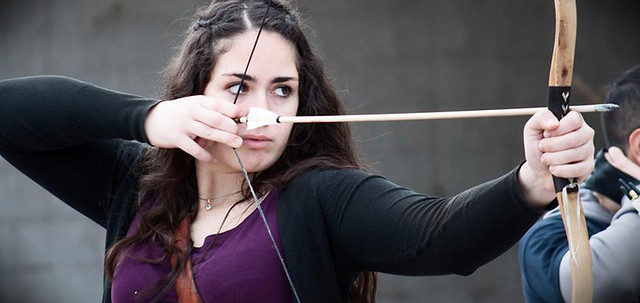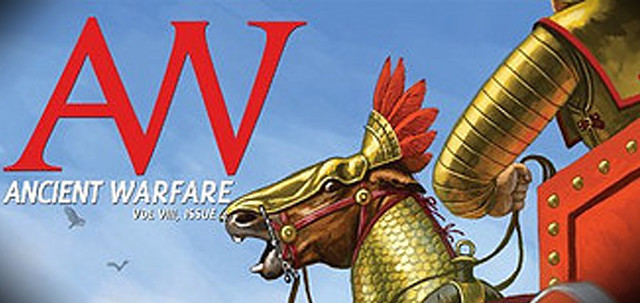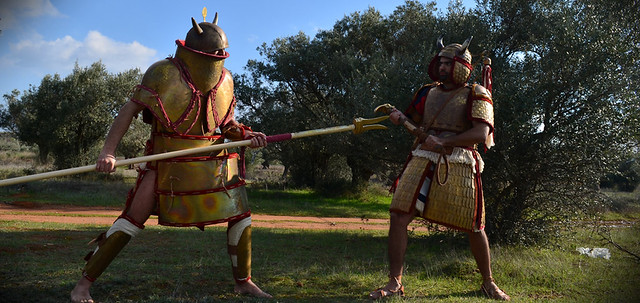Αλιάδης Αντώνης, Σπύρος Μπάκας - Σύλλογος Ιστορικών Μελετών ΚΟΡΥΒΑΝΤΕΣ
The stereotype about the Homeric Heroes is about well armoured Warriors with swords and spears fighting in duels or primitive phalanxes/loose formations. Some of them were exceptional archers using composite bows (eg. Pandaros, Odysseus). Αrchaeological findings among Egyptians, Mitannians, Caananites, Hittites, Summerians present us a large variety of "exotic" weapons like periform maces, disc maces, sickle swords, throwing sticks, heavy naval spears, etc.
The following is a short summary of the study found in the following page. It will brief on details and insight about four experimental reconstructions of Mediterranean Bronze age exotic weapons and three panoplies (armour) that KORYVANTES Association has worked on since 2011, as well as provide a brief on experiences from testing them as part of the bronze age Warrior armour system(s).
Axes - axini
Mycenaeans were using types of crescent axes, piercing axes but also the so called epsilon axe, which is a probably an evolution of the Egyptian duck-bill axe. Minoan axes were typically double blade axes, while there are strong arguments that those axes were ceremonial/votive or associated with female ritual figures. Mycenaeans and Minoans also have used decorated single bladed axes, as documented by archaeological findings from Crete to North Europe. Another interesting axe design comes from Hittites, as depicted on the inner side of the King's gate at Hattusa. The shape of the axe reminds double warthog teeth, thus we refer to it as warthog axe. Usage of battle axes (both one-handed and two-handed) is a necessity for the period Warriors as effective plate and scale armour had been developed and used (i.e. Dendra Plate Armour, Thebes-Arsenal armour, Hittite scale armour, etc) - similar weapons are used to defeat 15th century West European medieval knights armour, as well as used by /against Byzantine Catafracts and sailors.
It is a fact though that Homer describes briefly some unusual (and less-noble) weapons, like axes clubs (Iliad 7.138) and aksini (Iliad 15.711). War clubs maces were typical weapons of the Bronze era. Homer describes it as great bar clubbed of iron (Iliad 7.138). Findings of spherical or periphorm maces document their usage in all armies of the era (Egypt, Hittite Kingdom, North Europe, Mycenaeans, etc). Various materials were used to build war maces (iron, bronze, stone), depending of the social status and financials of the Warrior. Some archaeological findings though (Agia Triada near Phaistos/Crete) present us some exceptional examples of mallet war maces.

Mycenaean noble warrior and followers. The warrior is armed with a typical Mycaenenan “epsilon blade” axe based on exhibits from National Archaeological Museum. His follower is armed with an "axini" reinforced with bronze spikes. Courtesy of Living history Association “Koryvantes”
Homer makes a distinct reference to an unusual weapon, the aksini. It was used to attack Menelaus, who survived the attack and killed the Trojan Warrior (Iliad 13.613), so there is a clear distinction between war clubs / axes and axini. It is a fact also that are not concrete archaeological findings, documentation and written evidence regarding aksini usage and shape, this has lead to a confusion with battle axe. The word axini is used even today in modern Greek language to describe an agricultural tool (pickaxe). Some advise from linguistic experts is needed to clarify the meaning of axini in Ancient Greek eras. But we may assume that improvised agricultural tools were use as weapons by poorer Warriors, this is a safe guess. What is interesting is that Kanellopoulos Museum in Athens exhibits an interesting artifact dated in the 9th century bc: a heavy hammer with long-horned ending, similar to modern axini. If this was a weapon of the era, was clearly designed to puncture through heavy armour or grab/tear apart opponent plate armour, just like the West European horseman picks.

Modern reconstruction of Mycenaean Warrior armed with “axina” Based on exhibits from Kanellopoulos Museum and National Archaeological Museum Courtesy of Living history Association “Koryvantes”
Bronze Age Mycaenean technology was capable to produce highly effective plate and scale armors for the warriors in massive numbers. It is a safe guess to assume that Kanelopoulos Museum artifact was a weapon with the necessary shape and mass to deliver effective crushing blows and perforate composite armors of the era.
Bronze Age Mycenaean technology was capable of producing highly effective plate and scale armours for the Warriors in massive numbers, as Mycenaean and Minoan logistics documents reveal. It is a safe guess to assume that Kanellopoulos Museum artifact was a weapon with the necessary shape and mass to deliver effective crushing blows and perforate the composite panoplies of the era.
Navmaho xisto (?) - heavy naval spear / boarding pick
Homer refers to navmaha xista (ναύμαχα ξυστά) - boarding picks (Iliad. Ο. 388 - 389, 676 - 678), as special weapons of Achaeans for naval warfare. Our inspiration for this type of weapons was an image from the exceptional site of Andrea Salimbeti. The peculiar bronze double-headed blade is dated around 16th Century BC found at Agios Onoufrios near Phaistos, Crete. The shape of the artifact loosely reminds an agricultural tool called δικράνι - dikrani, some refer to the artifact with this term.
Officially this artifact has been interpreted as a fish-spear. This may have been used in conjunction with a net, or on its own from an open boat. We assume that was used like a harpoon to kill captured large fishes (swordfish) or sea mammals (seals, whales, dophins) - the heavyweight spearhead fit perfectly in this scenario (vertical hit from boat decks downwards to sea level), multiplying the forces and delivering devastating power to penetrate the thick skin of the pray. Also the shape of the spearhead seem to be ideal for the role, though we conducted no tests for this.
Another interesting interpretation for this artifact is that is a social or religious symbol, as the shape is similar to the most characteristic Minoan religious symbol, the horns of the "sacred bull"
For the full study, please refer to the the following page.
Λαμία
Αντώνης Αλιάδης Γιώργος Κανακάρης Κάτσος Γιώργος Σπύρος Μπάκας Λαμία Κορύβαντες Νικόλαος Κλεισιάρης Λαμία Κορύβαντες Παραδοσιακή Τοξοβολία
-- 




ΕΞΑΙΡΕΤΟ ΑΡΘΡΟ, ΣΥΓΧΑΡΗΤΗΡΙΑ!
ΑπάντησηΔιαγραφήΣας ευχαριστουμε κε Μαρίνη!
ΑπάντησηΔιαγραφή